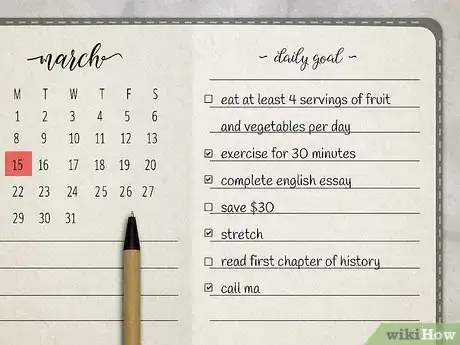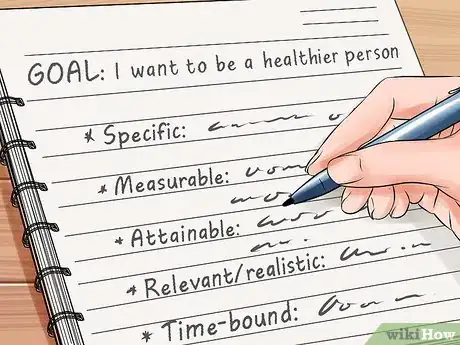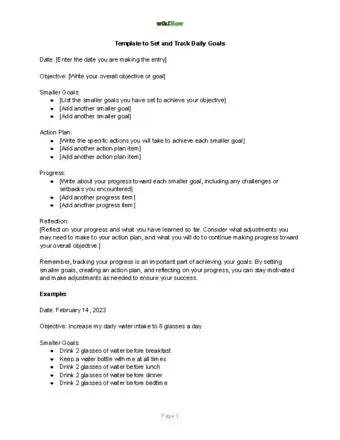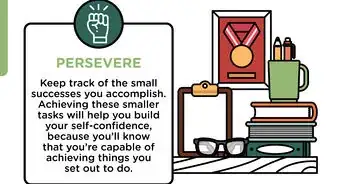This article was co-authored by Sandra Possing. Sandra Possing is a life coach, speaker, and entrepreneur based in the San Francisco Bay Area. Sandra specializes in one-on-one coaching with a focus on mindset and leadership transformation. Sandra received her coaching training from The Coaches Training Institute and has seven years of life coaching experience. She holds a BA in Anthropology from the University of California, Los Angeles.
There are 10 references cited in this article, which can be found at the bottom of the page.
This article has been viewed 81,231 times.
Are you unhappy with how disorganized your life feels? Maybe you have big plans for your life, but have no idea how to achieve them. While writing your goals is important, it's critical to find ways of realizing and achieving those goals. You may find that with personal development and achieving your goals, you're able to improve your well being and overall happiness.
Steps
Writing Your Goals
-
1Make a list of all of your goals.[1] Include all of your weekly, monthly, yearly, or life goals. This will let you rank them according to how important they are to you. Spend some time thinking about how long each goal will take and whether they're achievable.[2] [3]
- When you first start writing goals, don't be afraid to dream big! You can always go back and come up with smaller goals to help you.[4]
- Always try to be as specific as possible when brainstorming your goals. This way, you clearly understand the steps you need to take to achieve any life plans or short-term goals.
-
2Break your goals into daily steps.[5] Once you've found future dreams and ideals, choose a few specific goals to help you reach them. If your goal is large or long term, break it up into smaller goals or steps. Make sure to give yourself enough time to complete large projects or goals. This way, every day you can work towards achieving them.[6] [7]
- Breaking up a goal into daily goals or steps can reduce your stress, making you happier in the long run.[8]
Advertisement -
3Set benchmarks and deadlines. Don't become so focused on setting daily or smaller goals, that you lose sight of your overall goal or plan. Setting deadlines and reaching them will give you a sense of accomplishment, increase your motivation, and give you feedback about what's working and what's not.
- Try using a calendar as a visual cue for keeping you committed to your goals and the timeline you set for yourself. It is also extremely satisfying to cross out a completed goal or objective.
-
4Try the S.M.A.R.T. model for setting goals. Look at each of your goals and write down how the goal is specific (S), measurable (M), attainable (A), relevant or realistic (R), and time-bound, having deadlines (T).[9] For example, here's how you could take a vague goal, like "I want to be a healthier person,” and make it more specific using S.M.A.R.T:[10]
- Specific: "I want to improve my health by losing some weight."
- Measurable:"I want to improve my health by losing 20 pounds."
- Attainable: While you may not be able to lose 100 pounds, 20 pounds is an achievable goal.
- Relevant/realistic: You might remind yourself that losing 20 pounds will give you more energy and make you feel happier. Remember you're not doing this for anyone else.
- Time-bound: “I want to improve my health by losing 20 pounds within the next year, with an average of 1.6 pounds a month.”
Making Achievable Daily Goals
-
1Set a realistic time frame. For short term goals, ask yourself how long the project should take and set a deadline. If it's a longer goal, consider how long each step will take and add the time of each step together. It's a good idea to add a little extra time (either a few more days or weeks), just in case unforeseen things come up. Regardless of the type of goal, make sure it's achievable.
- For example, if you work a full-time job, volunteer for 10, and work out for 5, adding 20 hours a week towards a goal may not be realistic. This will make it harder to commit to and complete the goal.
-
2Set a daily routine. If your lifestyle and goals permit it, create a daily routine. While a routine may sound inflexible or boring, it can reduce your stress by keeping you on track. Routines are critical for long term goals, since they keep you on a path towards your goal. They'll also help you develop good habits and provide structure.[11]
- You don't need to block out every hour of your day, you may just set goals for that day. For instance, you might plan on working for 3 hours, exercising for 1, and working on chores for the following 2 hours.
-
3Track your progress. Every day, consider where you're at in meeting your goals. If the goal is much further away, perhaps a life long goal like becoming more flexible, it is a good idea to set benchmarks. Benchmarks let you track gradual progress which can motivate you to continue working towards your goal. Tracking your achievements will also let you look back to see how far you've come and what you've already accomplished.[12]
- Take this time to measure your actions and achievements against your list of goals and calendar. You may need to readjust the schedule if you find yourself moving faster or slower than you expected.
-
4Take it one step at a time. You may be very eager to start a big project or goal. While this is great, consider how much you can actually take on. If you set unrealistic goals or take on too much work, your motivation and interest in the project may suffer. Try to take one step at a time and remind yourself you are working towards your goal.[13]
- Often taking the first step can be the hardest part. Once you take that first step, you may find you have more energy and motivation to keep going.[14]
- For example, if you're interested in improving your health by changing your diet, exercise routine, sleep schedule, and screen time habits, you may feel overwhelmed. Instead, focus on one issue at a time or take on a few, but set small goals for each one. This may make you more productive in the long run.
Template to Set and Track Goals
Expert Q&A
-
QuestionHow do I set daily goals to achieve my dreams?
 Sandra PossingSandra Possing is a life coach, speaker, and entrepreneur based in the San Francisco Bay Area. Sandra specializes in one-on-one coaching with a focus on mindset and leadership transformation. Sandra received her coaching training from The Coaches Training Institute and has seven years of life coaching experience. She holds a BA in Anthropology from the University of California, Los Angeles.
Sandra PossingSandra Possing is a life coach, speaker, and entrepreneur based in the San Francisco Bay Area. Sandra specializes in one-on-one coaching with a focus on mindset and leadership transformation. Sandra received her coaching training from The Coaches Training Institute and has seven years of life coaching experience. She holds a BA in Anthropology from the University of California, Los Angeles.
Life Coach Start by dreaming as big as you can! Write down whatever you want to accomplish, then come up with smaller goals you'll need to achieve that bigger goal.
Start by dreaming as big as you can! Write down whatever you want to accomplish, then come up with smaller goals you'll need to achieve that bigger goal.
References
- ↑ Sandra Possing. Life Coach. Expert Interview. 15 July 2020.
- ↑ https://www.sciencedirect.com/science/article/abs/pii/0146640278900024
- ↑ https://libres.uncg.edu/ir/uncg/f/d_schunk_self_1991.pdf.
- ↑ Sandra Possing. Life Coach. Expert Interview. 15 July 2020.
- ↑ Sandra Possing. Life Coach. Expert Interview. 15 July 2020.
- ↑ https://static1.squarespace.com/static/57309137ab48de6f423b3eec/t/588a1ad26b8f5b7b952129d4/1485445848820/Austin%26Vancouver1996.pdf
- ↑ https://home.ubalt.edu/tmitch/642/articles%20syllabus/locke%20latham%20new%20dir%20GS%20curr%20dir%20psy%20sci%202006.pdf
- ↑ https://positivepsychology.com/goal-setting-exercises/
- ↑ https://www.ucop.edu/local-human-resources/_files/performance-appraisal/How%20to%20write%20SMART%20Goals%20v2.pdf
- ↑ https://journals.tdl.org/absel/index.php/absel/article/viewFile/90/86
- ↑ https://www.northshore.org/healthy-you/how-to-start-a-new-routine-and-stick-to-it/
- ↑ https://www.fredonia.edu/student-life/career-development-office/successful-career-planning
- ↑ Sandra Possing. Life Coach. Expert Interview. 15 July 2020.
- ↑ Sandra Possing. Life Coach. Expert Interview. 15 July 2020.
About This Article
When you set daily goals, try writing down what you would like to accomplish each day. Set deadlines for throughout the day, and update your list as you complete tasks. Start small though, and build from there. If you'd like to exercise more for example, try going for a 15 minute jog the first day, then running a little bit longer the next day, and so on. Try to stick to a daily routine by waking up, eating meals, and going to bed at the same time everyday. For information about the S.M.A.R.T. model from our health reviewer, read on!





































































